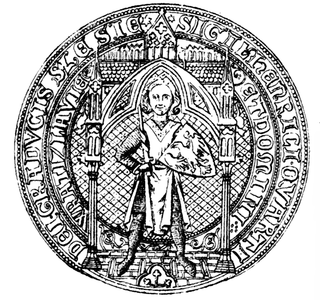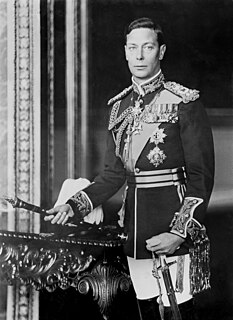Sources
| Regnal titles | ||
|---|---|---|
| Preceded by Ariulf | Duke of Spoleto 602–652 | Succeeded by Atto |
| | This biography of an Italian noble is a stub. You can help Wikipedia by expanding it. |
Theodelap or Theudelapius [1] was one of the sons of Faroald, the first Duke of Spoleto. [2] [ self-published source? ] After the death of Ariulf in 601 or 602, Theodelap and his brother fought for the throne. Theodelap won and was crowned duke. He held the dukedom for more than half a century, until his death. [3] His reign was nevertheless uneventful and he appears to have been largely or completely independent of royal authority throughout. He was succeeded by Atto.
| Regnal titles | ||
|---|---|---|
| Preceded by Ariulf | Duke of Spoleto 602–652 | Succeeded by Atto |
| | This biography of an Italian noble is a stub. You can help Wikipedia by expanding it. |
William I, usually known as William the Conqueror and sometimes William the Bastard, was the first Norman King of England, reigning from 1066 until his death in 1087. He was a descendant of Rollo and was Duke of Normandy from 1035 onward. His hold was secure on Normandy by 1060, following a long struggle to establish his throne, and he launched the Norman conquest of England six years later. The rest of his life was marked by struggles to consolidate his hold over England and his continental lands, and by difficulties with his eldest son, Robert Curthose.

Henryk IV Probus was a member of the Silesian branch of the royal Polish Piast dynasty. He was Duke of Silesia at Wrocław from 1266, and from also 1288 High Duke of the Polish Seniorate Province of Kraków until his death in 1290.

George VI was King of the United Kingdom and the Dominions of the British Commonwealth from 11 December 1936 until his death in 1952. He was also the last Emperor of India from 1936 until 1947, when the British Raj was dissolved.

Daufer was a king of the Lombard Kingdom of northern Italy, ruling from 756 to 774. He is chiefly known for his connection to Charlemagne, who married his daughter and conquered his realm.

The Spring and Autumn period was a period in Chinese history from approximately 771 to 476 BCE which corresponds roughly to the first half of the Eastern Zhou period. The period's name derives from the Spring and Autumn Annals, a chronicle of the state of Lu between 722 and 479 BCE, which tradition associates with Confucius.

Prince Edward, Duke of Kent and Strathearn, was the fourth son and fifth child of King George III. His only child became Queen Victoria.

King of Italy was the title given to the ruler of the Kingdom of Italy after the fall of the Western Roman Empire. The first to take the title was Odoacer, a barbarian military leader, in the late 5th century, followed by the Ostrogothic kings up to the mid-6th century. With the Frankish conquest of Italy in the 8th century, the Carolingians assumed the title, which was maintained by subsequent Holy Roman Emperors throughout the Middle Ages. The last Emperor to claim the title was Charles V in the 16th century. During this period, the holders of the title were crowned with the Iron Crown of Lombardy.

The Leonid dynasty produced five Roman emperors during Late Antiquity, reigning over the Roman Empire from 457 to 518. The dynasty's patriarch was Leo I, who was made Roman emperor in 457. Leo's daughter Ariadne became empress and mother to an emperor, and her two husbands were themselves each made emperor in turn. Another relative whose name does not survive of Leo I or his wife Verina married the future augustus Julius Nepos, the last emperor in the western Roman Empire. The dynasty of Leo succeeded the preceding Valentinianic dynasty and Theodosian dynasty whose family trees were conjoined and ruled concurrently. Besides Julius Nepos, who administered no more than a rump state the Roman province of Dalmatia in the western empire during the fall of the west, the dynasty's emperors governed the eastern empire.

Prince Milan Obrenović II of Serbia was the ruling Prince of Serbia for just four weeks in 1839.

The Residences of the Royal House of Savoy are a group of buildings in Turin and the Metropolitan City of Turin, in Piedmont. It was added to the UNESCO World Heritage Sites list in 1997.
Ariulf was the second Duke of Spoleto from 592 to his own death.
Transamund II was the Lombard Duke of Spoleto from 724 to 745, though he was twice driven from power by the king, Liutprand. Transamund rose to power by deposing his own father, Faroald II, and tonsuring him in a monastery.
Hilderic was the Lombard Duke of Spoleto briefly from 739 to 740. He was the first appointee of Liutprand, King of the Lombards, against the rebellious Thrasimund II.
Faroald I was the first Duke of Spoleto, which he established during the decade of interregnum that followed the death of Alboin's successor. He led the Lombards into the centre of the Italian peninsula while Zotto led them into the south.
Thrasimund I or Transamund I was the Count of Capua and then Duke of Spoleto, a faithful follower of Grimoald I of Benevento.
Agiprand was briefly the Duke of Spoleto between 742 and 744.
Theodicius was the Duke of Spoleto from 763 to 773. Though it is often stated that he died at the Siege of Pavia (774), he was still alive on 9 June 776, when Charlemagne confirmed the properties of the monastery of Farfa and Abbot Ingoald in the reign of his successor Hildeprand.
Gisulf was the Duke of Spoleto from 759 to 761.

Edward VIII was King of the United Kingdom and the Dominions of the British Empire, and Emperor of India, from 20 January 1936 until his abdication in December of the same year.
Marie of Mecklenburg, born sometime between 1363 and 1367, but probably by 1365, dead after 13 May 1402, was a duchess of Pomerania. She was the daughter of Duke Henry III, Duke of Mecklenburg and the Danish princess Ingeborg of Denmark, Duchess of Mecklenburg, was Duchess of Pomerania.